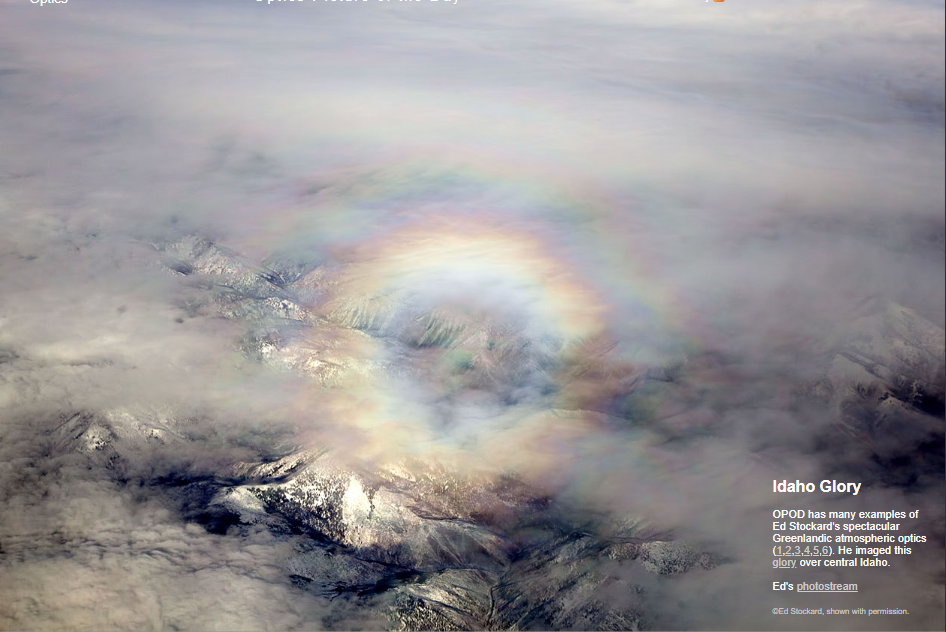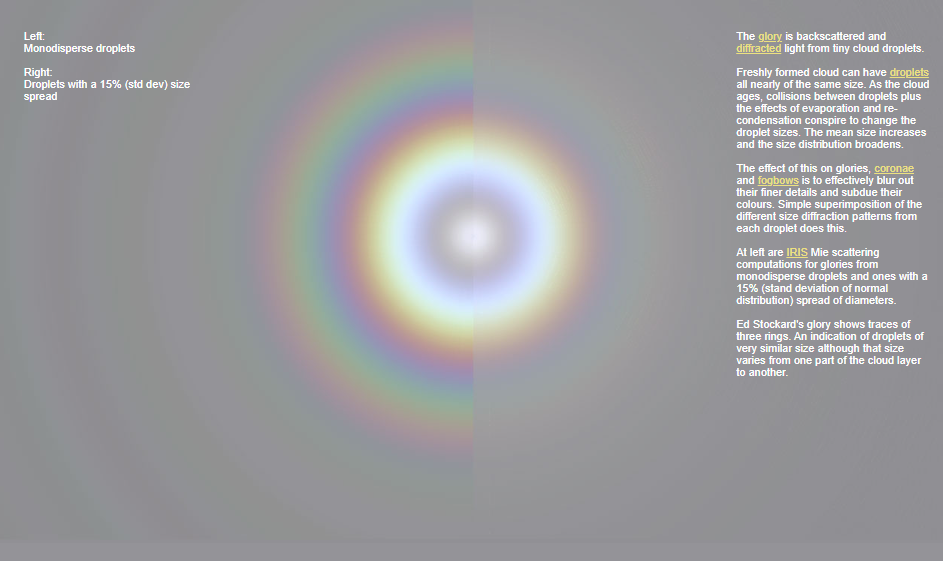OPOD - Idaho Glory
OPOD - Idaho Glory: A Spectacular Display of Atmospheric Optics
Have you ever witnessed the breathtaking beauty of an atmospheric phenomenon known as a glory? If not, let me introduce you to the mesmerizing "Idaho Glory" captured by the talented photographer Ed Stockard. This remarkable image showcases the interplay of backscattered and diffracted light from tiny cloud droplets, resulting in a stunning display of colors and rings.
When clouds form, they initially consist of droplets that are nearly uniform in size. However, as the cloud ages, various factors come into play that can alter the size distribution of these droplets. Collisions between droplets, as well as the processes of evaporation and re-condensation, contribute to changes in droplet sizes. As a result, the mean size of the droplets increases, and the size distribution becomes broader.
The impact of these changes in droplet sizes can be observed in phenomena such as glories, coronae, and fogbows. These atmospheric optics phenomena appear blurred and their colors subdued due to the superimposition of different size diffraction patterns from each droplet. The finer details of these phenomena are effectively blurred out, creating a mesmerizing yet subtle display of colors and rings.
In the case of Ed Stockard's glory photograph, we can observe traces of three rings. These rings indicate the presence of droplets that are very similar in size, although their size may vary from one part of the cloud layer to another. This variation adds an element of complexity and intrigue to the Idaho Glory, making it a captivating sight for all who have the privilege of witnessing it.
To better understand the intricate details of glories and their formation, researchers use computational models like IRIS Mie scattering computations. These models allow scientists to simulate the diffraction patterns produced by different types of droplets. By comparing the results from simulations using monodisperse droplets (droplets of uniform size) and droplets with a 15% spread in diameters, we can gain insights into the effects of droplet size distribution on the appearance of glories.
In summary, the Idaho Glory captured by Ed Stockard serves as a stunning example of atmospheric optics at its finest. This captivating phenomenon is a result of backscattered and diffracted light from cloud droplets, with their size distribution playing a crucial role in shaping the appearance of glories. The interplay of light and droplets creates mesmerizing rings and colors that add a touch of magic to our skies.
Next time you find yourself gazing at the clouds, keep an eye out for the elusive glories. Who knows, you might be fortunate enough to witness your very own Idaho Glory, a fleeting moment of atmospheric wonder that will leave an indelible mark on your memory.

Idaho Glory
OPOD has many examples of Ed Stockard's spectacular Greenlandic atmospheric optics (1,2,3,4,5,6). He imaged this glory over central Idaho.
Ed's photostream
©Ed Stockard, shown with permission.
Left:
Monodisperse droplets
Right:
Droplets with a 15% (std dev) size spread

The glory is backscattered and diffracted light from tiny cloud droplets.
Freshly formed cloud can have droplets all nearly of the same size. As the cloud ages, collisions between droplets plus the effects of evaporation and re-condensation conspire to change the droplet sizes. The mean size increases and the size distribution broadens.
The effect of this on glories, coronae and fogbows is to effectively blur out their finer details and subdue their colours. Simple superimposition of the different size diffraction patterns from each droplet does this.
At left are IRIS Mie scattering computations for glories from monodisperse droplets and ones with a 15% (stand deviation of normal distribution) spread of diameters.
Ed Stockard's glory shows traces of three rings. An indication of droplets of very similar size although that size varies from one part of the cloud layer to another.
Note: this article has been automatically converted from the old site and may not appear as intended. You can find the original article here.
Reference Atmospheric Optics
If you use any of the definitions, information, or data presented on Atmospheric Optics, please copy the link or reference below to properly credit us as the reference source. Thank you!
-
<a href="https://atoptics.co.uk/blog/opod-idaho-glory/">OPOD - Idaho Glory</a>
-
"OPOD - Idaho Glory". Atmospheric Optics. Accessed on November 26, 2024. https://atoptics.co.uk/blog/opod-idaho-glory/.
-
"OPOD - Idaho Glory". Atmospheric Optics, https://atoptics.co.uk/blog/opod-idaho-glory/. Accessed 26 November, 2024
-
OPOD - Idaho Glory. Atmospheric Optics. Retrieved from https://atoptics.co.uk/blog/opod-idaho-glory/.